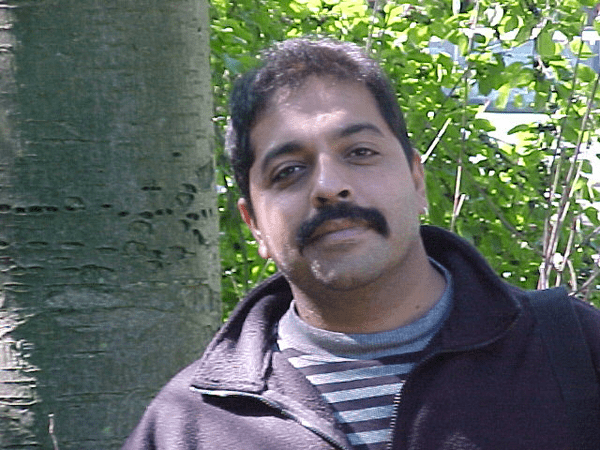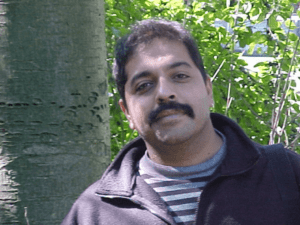Afterword: Sanjay Talreja

Rebecca Fisseha
September 17, 2013


Ordinary people are subjects of fascination for Sanjay—how they make things happen, how things happen to them, how they manage with the reverberations of the world around them. In his stories, he traces the impact of sweeping events on everyday lives. His work looks at ordinary people in their everyday world—coping with a world not of their own making, sometimes as heroes, sometimes as victims but mostly doing almost mundane things that matter to their own lives, but always within contexts, circumstances and history.
Sanjay believes that the effects of history linger on, connecting everyone in small ways. This is also behind his passion for creating documentaries. Gifted with an ability to observe without interfering, Sanjay has interviewed and spent time with people from myriad walks of life. Sanjay quotes Studs Terkel in Working, saying people are open and willing to share details of their lives if they are approached with compassion. They want to tell their stories, and Sanjay is happy to facilitate. His fiction work in turn allows him to creatively interpret what he knows of taxi drivers, cooks, store clerks, business owners and bureaucrats.
The story behind the title of the collection—Homecoming—follows Mr. Dalal, an older Indian man who returns to India, where he had spent a majority of his life, after having lived a second life with his adult children in the US. As such, he is doubly bewildered—by life in America and New India. This sense of bewilderment, the almost childlike and solitary emotional space of being at the mercy of both randomness and causality where no explanation quite suffices, influences the stories Sanjay chooses to tell.
Sanjay had had no intention of applying to the DD long-form mentorship program. At the urging of his wife, he pulled out his story Homecoming, drafts of stories and ideas, and “cobbled together” a collection. When he was selected and therefore bound to completing the stories, he quickly explained to his mentor Moez Surani that many of his stories were in an early phase.
Having previously worked with mentors, Sanjay knew that it can at times be a token process, without real commitment from either side. At DD, however, there was serious commitment from all sides. The considerable age difference between himself and Moez had given Sanjay pause, but his apprehension was dispelled when the two met and hit it off. The real cause for alarm turned out to be Sanjay’s already full schedule. A freelance filmmaker, he was already deep into a feature film and a documentary and was also working on a dramatic feature length script. Time management became key; Sanjay “ping-ponged” between stories and, mediums, thanks to his flexible schedule and steady support from his wife’s full-time job, delivered story drafts on the dates that he and Moez had set. For current and future mentees, Sanjay advises sticking to your deadlines, no matter what. In addition, he recommends having a professional but open, respectful relationship with your mentor.
Since handing in the final drafts of the stories in Homecoming, Sanjay has met with DD president Helen Walsh to discuss the possibility of approaching to publishers. With the exception of a couple of the pieces, they both feel that, while each story is aesthetically unique, it is a cohesive collection. Once those have been revised, the manuscript will be ready to send out. Not that Sanjay is in any hurry to do so. Starting out, his only intent had been to see if he had the ability to do something other than filmmaking. Coming from a screenwriting background, Sanjay has found writing short stories to be far more pleasurable, not only for the creative control but also because the writer can delve into the interior space of a character.
As for readership, Sanjay has no specific one in mind, though he will say that he’s not interested in accommodating the reader by explaining every unfamiliar cultural reference –better to allow for multiple levels of enjoyment.
The last third of Homecoming was the most challenging for Sanjay to write, as he had to tread a fine line between wholly factual versus impressionistic descriptions of the Bombay riots, a turning point in the lives of all involved near and far, including Mr. Dalal and Sanjay himself.
Sanjay has set himself a writing challenge: as much as he wants to demonstrate that non-Western peoples have their ordinary lives too –“Getaway” is a simple tale of a guy who just wants to have a day by himself, “The Kick” was inspired by the story of a dentist rumored to be a lecherous creep—he also feels called to locate these lives within very particular circumstances. Often, this involves setting the record straight about the so-called “timeless” peoples of the East, who are often portrayed as fixed, outside history prior to their contact with the West. He cites Binyavanga Wainaina’s How to Write About Africa and Eric Wolf’s Europe and the People Without History as insightful commentaries on this phenomenon. Sanjay feels that he will always be struggling to correct such a-historical attitudes, showing how events that happen in the distant past have an impact on the present, which in turn will have an impact on the distant future of all.
The opposite happens as well, says Sanjay; Indians who migrate, knowingly or not, cling to a fixed notion of India and Indian-ness, even while the country is changing very rapidly. Part of it is a survival tactic, common to all diasporas. Sanjay suggests that since Indians look different, they have no chance of disappearing into whiteness. Since becoming fully American or Canadian is not a real option, some become more Indian/Chinese/Jewish, taking comfort in the sense of superiority it affords.
In the case of India, as has been Sanjay’s own experience, there then comes the shock of going back home to discover that locals who were once eager to migrate now berate him for having done so—such is the abundance of opportunity. But the system has also changed beyond his or any returnees’ ability to fully decipher. What he can do, going forward with his screenplays and short stories, is remain true to his own sensibilities and values –Indian and Canadian—in his re-presentations of people in history.
